Sweet Magnolia |
Although many areas of our country are still blanketed in snow as I write this, and winter is officially upon us for another month at least, my thoughts are already looking toward spring and all its possibilities. Here along the southeast coast, spring can unofficially start as early as late February or early March when the daily temperatures rise to the mid 60's or lower 70's. I'm sure all of you who are reading this have a favorite spring photo spot. The kind of place you feel drawn to year after year because there's always something new to offer. For me, that place is Magnolia Plantation and the Audubon Swamp Garden in Charleston South Carolina.
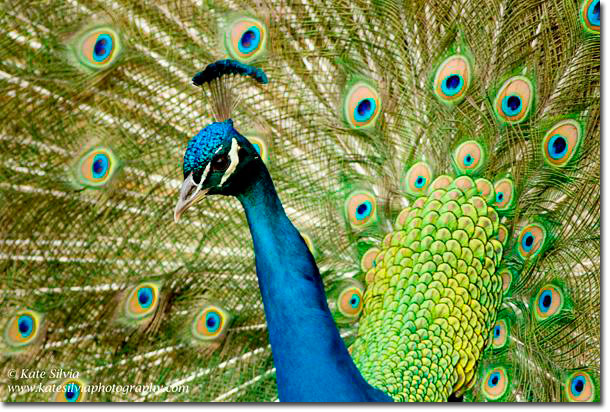
Located just 10 miles from historic downtown Charleston, Magnolia's 500+ acres were opened to the public in the 1870's. The gardens and grounds offer an endless array of photographic opportunities 365 days a year. Whether your area of interest is landscapes, macro, wildlife, or man and nature, you'll find enough subject matter to fill a week's worth of shooting and then some. Hop on the "nature train" for a quick overview of the entire plantation grounds. If you visit between March and November, take advantage of the nature boat that tours the local wetlands along the Ashley River for up close views of many species of waterfowl, reptiles and amphibians. If the family comes along, be sure to spend some time in the petting zoo with peacocks, white tailed deer, goats, rabbits, and other friendly critters. Magnolia also offers miles of hiking and bike trails as well as opportunities for canoeing if you want to get off the beaten path.
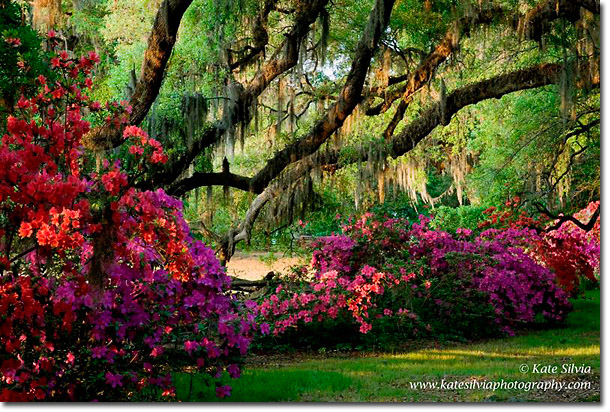
Despite the fact that you can have a wonderfully productive photo outing any time of year at Magnolia, spring is by far the best time to visit. Specifically, late March to early April when an explosion of color occurs with the annual azalea bloom. You can be fairly confident that the azaleas will peak during this period, but I would advise calling or emailing in advance, if your schedule will allow some last minute alterations, to ensure that the blooms are on time. During the spring of 2010 the azaleas did not peak until the third week of April, which was highly unusual. Beginning in March, you will find 5 species of azalea blooming along with crabapple, flowering cherry and pear, star magnolia, daffodils and many more. In April, you will also see wisteria, redbud, roses, iris, dogwood, tea olive and jasmine to name just a few. You won't see the classic southern magnolia until May. A complete list of what's blooming during your visit can be found at the administrative office when you arrive, or you can email them at camelliaman@msn.com to get the latest horticultural information.
Photographers be warned, however, for when the blooms arrive, so do the crowds! You may be fighting for tripod space at some of the more popular locations along the banks of the Ashley River or near one of the many footbridges over the swamps which produce classic reflections in calm weather. Many photographic field trips and workshops are going on at this time as well, but with 500 acres, you should be able to find a quiet spot from time to time. The best times to visit are typical of any tourist spot, during the week and early in the day. The gates open at 8:00 a.m. this time of year and 8:30 a.m. November through February. With sunrise happening around 7:00 a.m. during the peak azalea bloom, you should be able to catch a good bit of warm morning light before it gets crowded. Many of the garden areas do not even begin to receive light until 9:00 a.m. or later because of the height and abundance of live oak trees throughout the grounds.
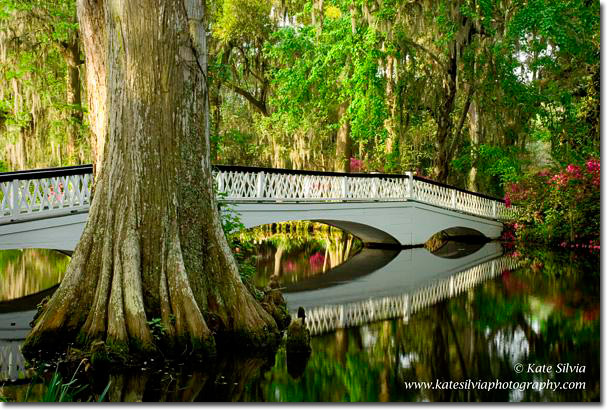
If you only have a day to spend here, you'll want to decide ahead of time where you want to concentrate the bulk of your time and that location depends on what you'd like to photograph. If colorful landscapes, macro photography, or a mixture of nature and history are your priority, then spending the majority of your visit in the gardens of Magnolia Plantation is what you'll plan for. However, if your focus is on wildlife, you really can't do much better than the Audubon Swamp Garden. The garden is a 60 acre black water cypress and tupelo swamp that is reached via Magnolia Plantation. You will get your passes for the swamp when you buy tickets to the plantation. Extra cost is involved.
Over 250 species of birds can be found in the Audubon Swamp Garden and Magnolia Plantation. Some of the more common species you'll encounter are several species of heron and egret, white ibis, anhinga, wood duck, clapper rail, common moorhen, osprey, red tailed hawk, bald eagle, eastern screech owl, the Carolina chickadee and many, many more. Over 80 species of bird may be found nesting on the refuge and the "rookery" is an extremely popular location for photographers during the nesting season. Egrets and herons will be building their nests while the peak azalea bloom is occurring. You may even spot a few youngsters peaking out of their nests a little early.
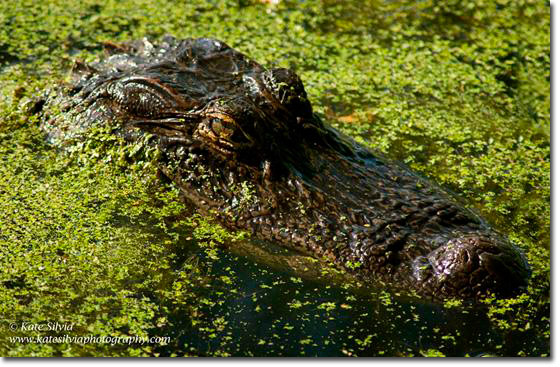
Along with the amazing avian opportunities in the swamp garden, you'll be in close proximity to several reptile and amphibian species as well, including the American alligator, which can be seen basking in the sun throughout the swamp. But check close to you as well as he may be lurking in the duckweed 3 feet from the path you're walking on. Did I mention that there are no real barriers between you and them? Great for photographing this intimidating subject, but not so great for the easily intimidated photographer. I have also encountered venomous snakes along the path so watch your step. This is their home after all and I always give them the right of way. Probably a wise choice!
Whether your visiting the gardens for an afternoon or taking advantage of everything Magnolia has to offer for several days, plan ahead with the proper supplies and gear to assure yourself greater success and less frustration in the field. Spring and fall are "sand gnat" season along coastal South Carolina. Otherwise known as "no-see-ums" or the "biting midge", these pesky critters can ruin a good photography outing simply by irritating the heck out of you, getting into your equipment and biting you madly. Bug spray is a necessity! I always wear a hat, carry a small bottle of sunscreen in my camera bag and bring water and snacks. There is a small snack shack at the plantation but no food is available at the swamp garden. Restroom facilities can be found at both locations.
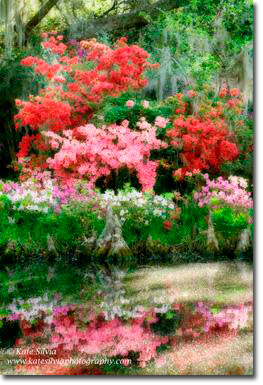
As far as what photo gear to bring, all I can say is that on any given day I've used every lens I've got ranging from 12mm to 300mm and my macro lens as well. Longer focal length lenses in the 400-600mm range can be helpful in the swamp garden to photograph some of the animals that prefer to steer clear of onlookers, but you can still find plenty to photograph with even a 200mm lens. A tripod is also essential for achieving tack sharp images throughout the gardens and grounds. Some incredible HDR photography possibilities exist here so having a remote release for your camera will benefit you as well. It goes without saying to bring plenty of memory cards, but you may want to bring your favorite gadget for backing up your images in the field. I've got an Epson P-6000 multimedia photo viewer that I love. I always have a polarizing filter for each of my lenses and neutral density filters have also come in handy when I feel like getting creative or if I'm forced to photograph in the middle of the day and I need to tame the light.
When you're planning your spring outings this year, if you happen to be near Charleston, South Carolina, consider adding Magnolia Plantation and the Audubon Swamp Garden to your itinerary. You won't regret it! Sweet Magnolia will never let you down.
For more information on the plantation and grounds, please visit www.magnoliaplantation.com or call 1-800 -367- 3517.
Comments on NPN nature photography articles? Send them to the editor. NPN members may also log in and leave their comments below.
 Kate Silvia is an award winning nature and outdoor portrait photographer based in Charleston, South Carolina. Kate was trained at the world's largest and oldest photography school, the New York Institute of Photography. Her articles and photos have been published in Nature Photographer Magazine, Aquarium Fish Magazine, Marine Fish and Reef Magazine, and others. She has served as the coordinator for the Asheville, NC region of the Carolinas' Nature Photographers Association and is a member of NANPA.
Kate Silvia is an award winning nature and outdoor portrait photographer based in Charleston, South Carolina. Kate was trained at the world's largest and oldest photography school, the New York Institute of Photography. Her articles and photos have been published in Nature Photographer Magazine, Aquarium Fish Magazine, Marine Fish and Reef Magazine, and others. She has served as the coordinator for the Asheville, NC region of the Carolinas' Nature Photographers Association and is a member of NANPA.
Her images can be seen at www.katesilviaphotography.com and you can follow her on her Facebook Page
.